Which Is A Predicted Impact Of Climate Change In The United States?
On This Page
- Increasing greenhouse gas concentrations will accept many furnishings
- Time to come temperature changes
- Future ice, snowpack, and permafrost
- Future sea level alter
- Future precipitation and storm events
- Time to come ocean acidification
Increasing greenhouse gas concentrations will have many effects
Greenhouse gas concentrations in the atmosphere will keep to increase unless the billions of tons of our almanac emissions decrease substantially. Increased concentrations are expected to:
- Increase Earth'south average temperature
- Influence the patterns and amounts of atmospheric precipitation
- Reduce ice and snowfall embrace, as well as permafrost
- Raise bounding main level
- Increment the acidity of the oceans
- Increase the frequency, intensity, and/or elapsing of farthermost events
- Shift ecosystem characteristics
- Increment threats to man wellness
These changes will impact our food supply, water resource, infrastructure, ecosystems, and even our own health.
Future changes will depend on many factors
- NRCClimate Stabilization Targets increment in greenhouse gas concentrations
- Natural influences on climate (due east.thousand., from volcanic action and changes in the sunday's intensity) and natural processes within the climate arrangement (e.k., changes in ocean circulation patterns)
Scientists use computer models of the climate system to better empathise these bug and project future climate changes.
Past and nowadays-24-hour interval greenhouse gas emissions will affect climate far into the future
Many greenhouse gases stay in the temper for long periods of fourth dimension. Equally a result, even if emissions stopped increasing, atmospheric greenhouse gas concentrations would continue to increment and remain elevated for hundreds of years. Moreover, if we stabilized concentrations and the composition of today'southward atmosphere remained steady (which would require a dramatic reduction in electric current greenhouse gas emissions), surface air temperatures would continue to warm. This is considering the oceans, which shop heat, take many decades to fully answer to higher greenhouse gas concentrations. The ocean's response to higher greenhouse gas concentrations and higher temperatures will continue to impact climate over the next several decades to hundreds of years.[two]
To learn more about greenhouse gases, please visit the Greenhouse Gas Emissions page and the Greenhouse Effect section of the Causes of Climate Change page.
Because it is difficult to project furthermost future emissions and other human factors that influence climate, scientists use a range of scenarios using various assumptions about futurity economical, social, technological, and ecology conditions.
Click the paradigm to view a larger version.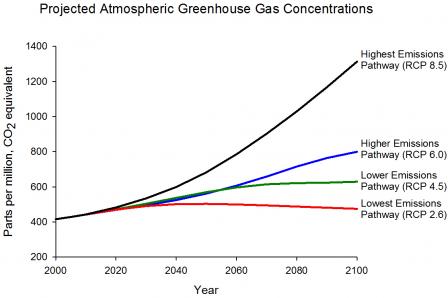 This figure shows projected greenhouse gas concentrations for four dissimilar emissions pathways. The top pathway assumes that greenhouse gas emissions will continue to rise throughout the current century. The bottom pathway assumes that emissions achieve a top between 2010 and 2020, failing thereafter.
This figure shows projected greenhouse gas concentrations for four dissimilar emissions pathways. The top pathway assumes that greenhouse gas emissions will continue to rise throughout the current century. The bottom pathway assumes that emissions achieve a top between 2010 and 2020, failing thereafter.
Source: Graph created from data in the Representative Concentration Pathways Database (Version 2.0.five) http://www.iiasa.ac.at/web-apps/tnt/RcpDb
Pinnacle of Page
Future temperature changes
We have already observed global warming over the last several decades. Future temperatures are expected to change further. Climate models projection the post-obit central temperature-related changes.
Fundamental global projections
- Increases in average global temperatures are expected to be within the range of 0.5°F to 8.6°F by 2100, with a likely increment of at least 2.7°F for all scenarios except the i representing the almost aggressive mitigation of greenhouse gas emissions.[two]
- Except under the well-nigh ambitious mitigation scenario studied, global average temperature is expected to warm at least twice as much in the next 100 years equally it has during the last 100 years.[two]
- Ground-level air temperatures are expected to continue to warm more than rapidly over country than oceans.[two]
- Some parts of the earth are projected to run across larger temperature increases than the global boilerplate.[2]
Click the image to view a larger version. Projected changes in global average temperatures under four emissions pathways (rows) for three different fourth dimension periods (columns). Changes in temperatures are relative to 1986-2005 averages. The pathways come up from the IPCC Fifth Assessment Written report: RCP2.6 is a very low emissions pathway, RCP4.v is a medium emissions pathway, RCP6.0 is a medium-high emissions pathway, and RCP8.5 is the high emissions pathway (emissions are assumed to proceed increasing throughout the century). Source: IPCC, 2013 Get out
Projected changes in global average temperatures under four emissions pathways (rows) for three different fourth dimension periods (columns). Changes in temperatures are relative to 1986-2005 averages. The pathways come up from the IPCC Fifth Assessment Written report: RCP2.6 is a very low emissions pathway, RCP4.v is a medium emissions pathway, RCP6.0 is a medium-high emissions pathway, and RCP8.5 is the high emissions pathway (emissions are assumed to proceed increasing throughout the century). Source: IPCC, 2013 Get out
Click the image to view a larger version. Observed and projected changes in global average temperature under iv emissions pathways. The vertical bars at right show likely ranges in temperature past the end of the century, while the lines prove projections averaged across a range of climate models. Changes are relative to the 1986-2005 boilerplate. Source: IPCC, 2013 Exit, FAQ 12.one, Figure ane.
Observed and projected changes in global average temperature under iv emissions pathways. The vertical bars at right show likely ranges in temperature past the end of the century, while the lines prove projections averaged across a range of climate models. Changes are relative to the 1986-2005 boilerplate. Source: IPCC, 2013 Exit, FAQ 12.one, Figure ane.
Key U.S. projections
- By 2100, the average U.Due south. temperature is projected to increase past about iii°F to 12°F, depending on emissions scenario and climate model.[i]
- An increment in average temperatures worldwide implies more frequent and intense extreme heat events, or heat waves. The number of days with high temperatures above 90°F is expected to increment throughout the United states, specially toward the end of the century.[1] Climate models project that if global emissions of greenhouse gases continue to grow, summertime temperatures in the The states that ranked among the hottest v% in 1950-1979 will occur at least 70% of the time by 2035-2064.[one]
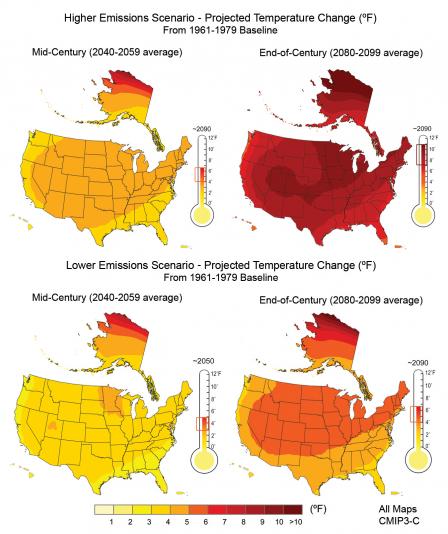 Projected temperature change for mid-century (left) and cease-of-century (right) in the United States under higher (summit) and lower (bottom) emissions scenarios. The brackets on the thermometers represent the likely range of model projections, though lower or higher outcomes are possible. Source: USGCRP (2009)
Projected temperature change for mid-century (left) and cease-of-century (right) in the United States under higher (summit) and lower (bottom) emissions scenarios. The brackets on the thermometers represent the likely range of model projections, though lower or higher outcomes are possible. Source: USGCRP (2009)
Top of Page
Future atmospheric precipitation and tempest events
Patterns of precipitation and storm events, including both rain and snowfall are as well probable to change. Even so, some of these changes are less certain than the changes associated with temperature. Projections show that futurity precipitation and storm changes will vary past flavour and region. Some regions may have less precipitation, some may have more than precipitation, and some may have piddling or no change. The amount of pelting falling in heavy precipitation events is likely to increment in most regions, while tempest tracks are projected to shift poleward.[2] Climate models project the following precipitation and storm changes.
Click the epitome to view a larger version. Projected changes in global annual mean precipitation for a low emissions scenario (left) and high emissions scenario (right). Blue and green areas are projected to experience increases in precipitation by the end of the century, while xanthous and brown areas are projected to experience decreases.
Projected changes in global annual mean precipitation for a low emissions scenario (left) and high emissions scenario (right). Blue and green areas are projected to experience increases in precipitation by the end of the century, while xanthous and brown areas are projected to experience decreases.
Source: IPCC, 2013 Leave
Cardinal global projections
- Global average annual precipitation through the end of the century is expected to increase, although changes in the amount and intensity of atmospheric precipitation will vary significantly by region.[2]
- The intensity of precipitation events will probable increase on average. This will be peculiarly pronounced in tropical and loftier-latitude regions, which are also expected to experience overall increases in atmospheric precipitation.[2]
- The force of the winds associated with tropical storms is likely to increase. The amount of precipitation falling in tropical storms is besides likely to increase.[two]
- Annual average atmospheric precipitation is projected to increase in some areas and decrease in others. The figure to the right shows projected regional differences in precipitation under two emission scenarios.[two]
Primal U.S. projections
- Northern areas are projected to become wetter, especially in the wintertime and spring. Southern areas, especially the Southwest, are projected to become drier.[1]
- Heavy precipitation events volition probable be more than frequent, even in areas where total atmospheric precipitation is projected to decrease. Heavy downpours that currently occur nearly once every twenty years are projected to occur between twice and 5 times every bit often by 2100, depending on location.[ane]
- The proportion of precipitation falling as pelting rather than snowfall is expected to increase, except in far northern areas.[1]
- The intensity of Atlantic hurricanes is likely to increase as the sea warms. Climate models project an increase in the number of the strongest (Category 4 and 5) hurricanes, equally well as greater rainfall rates in hurricanes.[one]There is less confidence in projections of the frequency of hurricanes.[1]
- Cold-flavor storm tracks are expected to continue to shift northward. The strongest common cold-season storms are projected to become stronger and more frequent.[1]
Click the paradigm to view a larger version.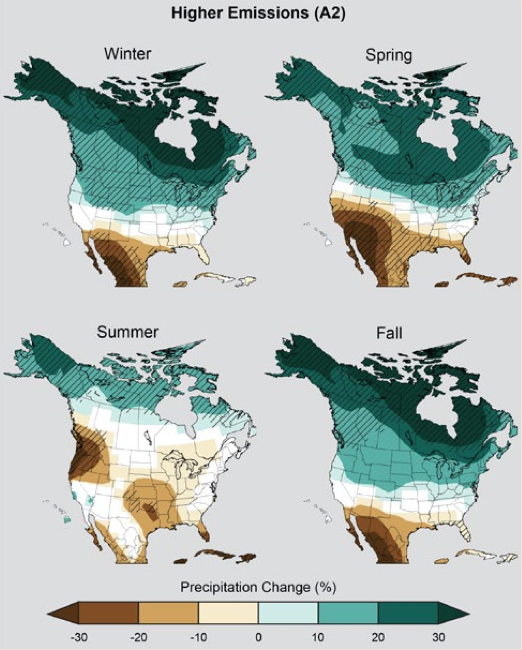 The maps evidence projected future changes in precipitation for the end of this century, compared with 1970-1999, under a college emissions scenario. For instance, in winter and bound, climate models agree that northern areas in the United States are probable to get wetter and southern areas drier. There is less conviction in exactly where the transition betwixt wetter and drier areas will occur. Confidence in the projected changes is highest in the areas marked with diagonal lines. The changes in white areas are non projected to be larger than what would be expected from natural variability. Source: U.Southward. National Climate Assessment, 2014.
The maps evidence projected future changes in precipitation for the end of this century, compared with 1970-1999, under a college emissions scenario. For instance, in winter and bound, climate models agree that northern areas in the United States are probable to get wetter and southern areas drier. There is less conviction in exactly where the transition betwixt wetter and drier areas will occur. Confidence in the projected changes is highest in the areas marked with diagonal lines. The changes in white areas are non projected to be larger than what would be expected from natural variability. Source: U.Southward. National Climate Assessment, 2014.
Top of Page
Futurity water ice, snowpack, and permafrost
Arctic body of water ice is already failing.[2] The area of snow comprehend in the Northern Hemisphere has decreased since about 1970.[2] Permafrost temperatures in Alaska and much of the Chill[ii] take increased over the concluding century.[i] To learn more about recent changes in snow and ice, visit the Snow and Water ice folio of the Indicators section.
Over the next century, it is expected that ocean ice will continue to decline, glaciers will proceed to shrink, snow encompass volition continue to subtract, and permafrost will keep to thaw. Potential changes to ice, snow, and permafrost are described below. Click the epitome to view a larger version.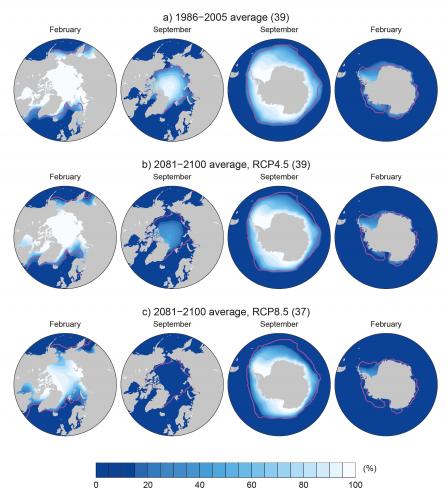 These maps evidence projected losses of sea ice in the Chill and Antarctica. The maps in a) testify the boilerplate ice concentration (the relative area covered by bounding main water ice) from 1986-2005. The maps in b) and c) show climate model simulations of body of water ice thickness in February and September near the terminate of the 21st century nether low (b) and high (c) emission scenarios. In the Arctic, February is projected to have less ice (more blue); September is projected to be nearly ice-gratis (virtually all bluish). The projected changes in Antarctic sea ice are more subtle. Source: IPCC, 2013
These maps evidence projected losses of sea ice in the Chill and Antarctica. The maps in a) testify the boilerplate ice concentration (the relative area covered by bounding main water ice) from 1986-2005. The maps in b) and c) show climate model simulations of body of water ice thickness in February and September near the terminate of the 21st century nether low (b) and high (c) emission scenarios. In the Arctic, February is projected to have less ice (more blue); September is projected to be nearly ice-gratis (virtually all bluish). The projected changes in Antarctic sea ice are more subtle. Source: IPCC, 2013
Key global projections
- For every 2°F of warming, models project about a fifteen% subtract in the extent of annually averaged Arctic ocean ice and a 25% subtract in the expanse covered by Arctic sea ice at the end of summer (September).[3] Note that this subtract does not contribute to bounding main level rising.
- The littoral sections of the Greenland and Antarctic ice sheets are expected to keep to melt or slide into the ocean. If the rate of this ice melting increases in the 21st century, the ice sheets could add significantly to global sea level ascension.[3]
- Glaciers are expected to continue to decrease in size. The rate of melting is expected to continue to increment, which will contribute to ocean level rise.[3]
Key U.S. projections
- Northern Hemisphere snowfall cover is expected to subtract by approximately xv% by 2100.[three]
- Models projection the snow season will continue to shorten, with snow accumulation beginning later and melting starting earlier. Snowpack is expected to decrease in many regions.[3]
- Permafrost is expected to continue to thaw in northern latitudes, damaging buildings, infrastructure, and ecosystems in Alaska.[3]
Top of Folio
Future body of water level change
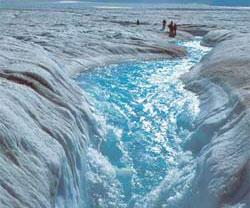 Meltwater flowing from the Greenland ice sheet Source: NASA Warming temperatures contribute to sea level rise by: expanding ocean water; melting mount glaciers and ice caps; and causing portions of the Greenland and Antarctic ice sheets to melt or catamenia into the ocean.[iii]
Meltwater flowing from the Greenland ice sheet Source: NASA Warming temperatures contribute to sea level rise by: expanding ocean water; melting mount glaciers and ice caps; and causing portions of the Greenland and Antarctic ice sheets to melt or catamenia into the ocean.[iii]
Since 1870, global ocean level has risen by about 7.5 inches.[2] Estimates of future ocean level rise vary for different regions, but global ocean level for the adjacent century is expected to rise at a greater rate than during the past 50 years.[2]Studies project global sea level to ascension by another i to 4 feet by 2100, with an doubtfulness range of 0.66 to half dozen.6 feet.[1]
The contribution of thermal expansion, ice caps, and small glaciers to sea level ascension is relatively well studied, simply the impacts of climate change on water ice sheets in Greenland and Antarctica are less understood and represent an agile area of research. Changes in water ice sheets are currently expected to account for i.2 to 8 inches of bounding main level rise by the cease of this century.[3]
Click the epitome to view a larger version.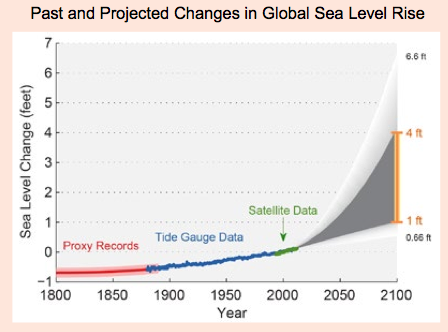 By and projected ocean level rise from 1800 to 2100. The orangish line at right shows the currently projected range of sea level rise of 1 to 4 feet by 2100; the wider range (0.66 feet to 6.6 feet) reflects uncertainty almost how glaciers and ice sheets will react to climate change. Source: NCA, 2014.
By and projected ocean level rise from 1800 to 2100. The orangish line at right shows the currently projected range of sea level rise of 1 to 4 feet by 2100; the wider range (0.66 feet to 6.6 feet) reflects uncertainty almost how glaciers and ice sheets will react to climate change. Source: NCA, 2014.
- 2.3 feet at New York City
- 2.9 feet at Hampton Roads, Virginia
- 3.five feet at Galveston, Texas
- i human foot at Neah Bay in Washington land
Relative sea level rise also depends on local changes in currents, winds, salinity, and water temperatures, as well as proximity to thinning ice sheets.[ii]
Tiptop of Folio
Future ocean acidification
Sea acidification adversely affects many marine species, including plankton, mollusks, shellfish, and corals. Equally sea acidification increases, the availability of calcium carbonate will reject. Calcium carbonate is a key building cake for the shells and skeletons of many marine organisms. If atmospheric CO2 concentrations double, coral calcification rates are projected to decline past more than 30%. If COii concentrations continue to rise at their current rate, the combination of climate warming and bounding main acidification could wearisome coral growth by nearly 50% by 2050.[5]
Click the image to view a larger version.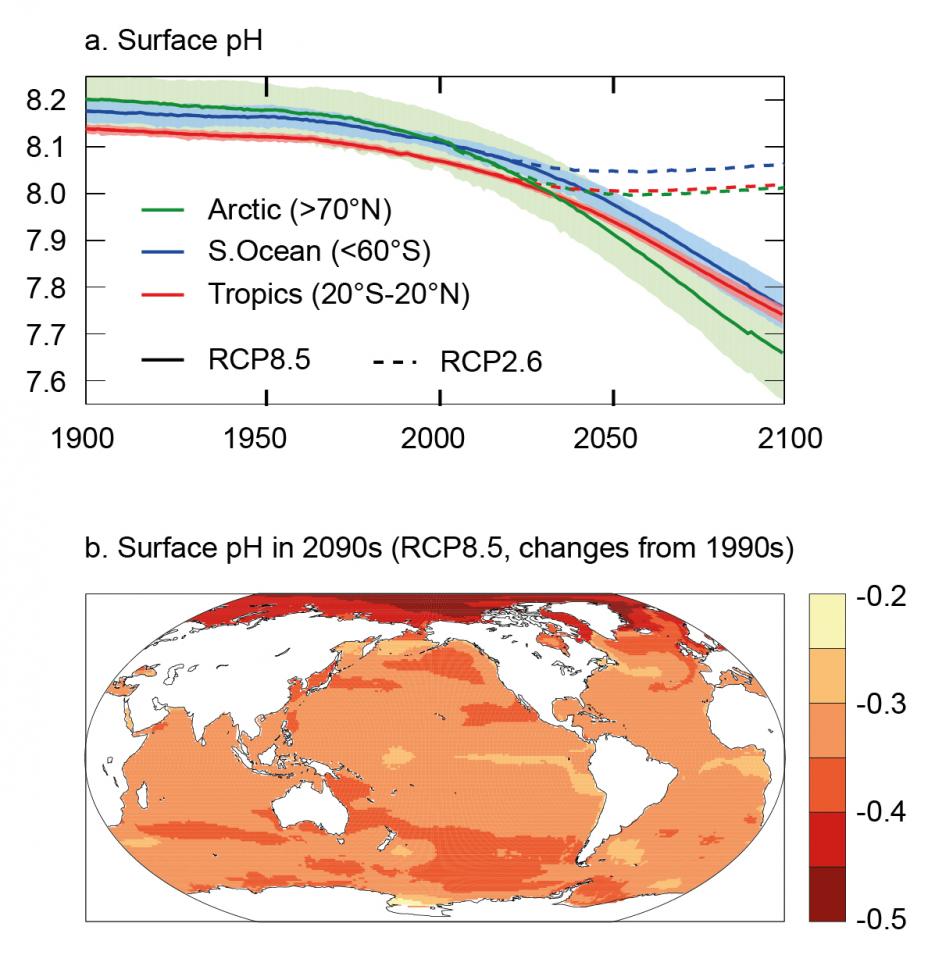 Oceans go more than acidic equally carbon dioxide (CO2) emissions in the atmosphere dissolve in the ocean. This modify is measured on the pH scale, with lower values being more acidic. The pH level of the oceans has decreased by approximately 0.1 pH units since pre-industrial times, which is equivalent to an approximately 30% increase in acidity. Equally shown in the graph and map above, the pH level of the oceans is projected to subtract fifty-fifty more by the end of the century every bit CO2 concentrations are expected to increase for the foreseeable future.[1] [2]Source: IPCC, 2013, Chapter half dozen.
Oceans go more than acidic equally carbon dioxide (CO2) emissions in the atmosphere dissolve in the ocean. This modify is measured on the pH scale, with lower values being more acidic. The pH level of the oceans has decreased by approximately 0.1 pH units since pre-industrial times, which is equivalent to an approximately 30% increase in acidity. Equally shown in the graph and map above, the pH level of the oceans is projected to subtract fifty-fifty more by the end of the century every bit CO2 concentrations are expected to increase for the foreseeable future.[1] [2]Source: IPCC, 2013, Chapter half dozen.
Top of Folio
References
[1] USGCRP (2014) Melillo, Jerry M., Terese (T.C.) Richmond, and Gary Westward. Yohe, Eds., 2014:Climate Modify Impacts in the United States: The 3rd National Climate Assessment. U.Due south. Global Alter Research Programme.
[2] IPCC (2013).Climatic change 2013: The Physical Scientific discipline BasisExit. Contribution of Working Grouping I to the Fifth Cess Report of the Intergovernmental Panel on Climatic change [Stocker, T.F., D. Qin, G.-K. Plattner, Thou. Tignor, Due south.K. Allen, J. Boschung, A. Nauels, Y. Xia, V. Bex and P.M. Midgley (eds.)]. Cambridge University Press, Cambridge, Great britain and New York, NY, USA.
[3] NRC (2011).Climate Stabilization Targets: Emissions, Concentrations, and Impacts over Decades to MillenniaExit. National Inquiry Council. The National Academies Press, Washington, DC, USA.
[4] USGCRP (2009).Global Climate Change Impacts in the United States. Thomas R. Karl, Jerry K. Melillo, and Thomas C. Peterson (eds.). Usa Global Alter Research Plan. Cambridge University Press, New York, NY, USA.
[5] IPCC (2014). Climatic change 2014: Impacts, Adaptation, and Vulnerability.
Top of Folio
Source: https://climatechange.chicago.gov/climate-change-science/future-climate-change
Posted by: amesbeferal.blogspot.com


0 Response to "Which Is A Predicted Impact Of Climate Change In The United States?"
Post a Comment